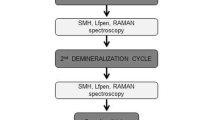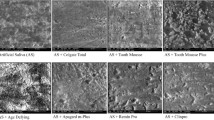Abstract
The purpose of this in vitro study was to investigate the efficacy of micro-Raman spectroscopy on detecting mineral content change during the demineralization and de/remineralization cycling process. The enamel samples (n = 55) were randomly divided into three groups and separately treated with demineralization solution (n = 20), de/remineralization cycling solution (n = 30), and distilled water (n = 5). Micro-Raman spectroscopy, microhardness (MHS), and the released calcium ions concentration were performed before and after treatment, respectively. A one-way analysis of variance (ANOVA) with a post hoc Tukey test was used to analyze the results. The Spearman correlation coefficients among the parameters of Raman relative intensity decrease (RRID%), the percentage of MHS loss (PML), and the released calcium ions concentration were also analyzed. In demineralization group, RRID%, PML, and released calcium ions concentration were highly correlated with each other (r = 0.979, p < 0.001; r = 0.984, p < 0.001; and r = 0.983, p < 0.001, respectively). While for the de/remineralization cycling group, there also existed a high correlation between RRID% and PML (r = 0.987, p < 0.001). In conclusion, micro-Raman spectroscopy could effectively monitor the mineral content change, and its efficacy was validated by the measurement of released calcium ions concentration and MHS.





Similar content being viewed by others
References
Mv S (1954) Organic constituents of enamel. J Am Dent Assoc 48:297–306
Angker L, Nockolds C, Swain MV, Kilpatrick N (2004) Correlating the mechanical properties to the mineral content of carious dentine—a comparative study using an ultra-micro indentation system (UMIS) and SEM-BSE signals. Arch Oral Biol 49:369–378
Sa Y, Liang S, Ma X, Lu S, Wang Z, Jiang T, Wang Y (2014) Compositional, structural and mechanical comparisons of normal enamel and hypomaturation enamel. Acta Biomater 10:5169–5177
Featherstone JD, ten Cate JM, Shariati M, Arends J (1983) Comparison of artificial caries-like lesions by quantitative microradiography and microhardness profiles. Caries Res 17:385–391
Kielbassa AM, Wrbas KT, Schulte-Mönting J, Hellwig E (1999) Correlation of transversal microradiography and microhardness on in situ-induced demineralization in irradiated and nonirradiated human dental enamel. Arch Oral Biol 44:243–251
Ten Bosch JJ, Angmar-Månsson B (1991) A review of quantitative methods for studies of mineral content of intra-oral caries lesions. J Dent Res 70:2–14
Mandurah MM, Sadr A, Shimada Y, Kitasako Y, Nakashima S, Bakhsh TA, Tagami J, Sumi Y (2013) Monitoring remineralization of enamel subsurface lesions by optical coherence tomography. J Biomed Opt 18:46006
Ko AC, Choo-Smith LP, Hewko M, Leonardi L, Sowa MG, Dong CC, Williams P, Cleghorn B (2005) Ex vivo detection and characterization of early dental caries by optical coherence tomography and Raman spectroscopy. J Biomed Opt 10:031118
Arends J, Ten BJ (1992) Demineralization and remineralization evaluation techniques. J Dent Res 71:924–928
Amaechi BT, Podoleanu AG, Komarov G, Higham SM, Jackson DA (2004) Quantification of root caries using optical coherence tomography and microradiography: a correlational study. Oral Hlth Prev Dent 2:377–382
Hall A, Girkin JM (2004) A review of potential new diagnostic modalities for caries lesions. J Dent Res 83:C89–C94
De Mul FFM, Hottenhuis MHJ, Bouter P, Arends J, ten Bosch JJ (1986) Micro-Raman line broadening in synthetic carbonated hydroxyapatite. J Dent Res 65:437–440
Tramini P, Pélissier B, Valcarcel J, Bonnet B, Maury L (2000) A Raman spectroscopic investigation of dentin and enamel structures modified by lactic acid. Caries Res 34:233–240
Gilchrist F, Santini A, Harley K, Deery C (2007) The use of micro-Raman spectroscopy to differentiate between sound and eroded primary enamel. Int J Paediatr Dent 17:274–280
Tsuda H, Arends J (1997) Raman spectroscopy in dental research: a short review of recent studies. Adv Dent Res 11:539–547
Hannig C, Hamkens A, Becker K, Attin R, Attin T (2005) Erosive effects of different acids on bovine enamel: release of calcium and phosphate in vitro. Arch Oral Biol 50:541–552
Jardim JJ, Pagot MA, Maltz M (2008) Artificial enamel dental caries treated with different topical fluoride regimes: an in situ study. J Dent 36:396–401
Marquezan M, Corrêa FN, Sanabe ME, Rodrigues FL, Hebling J, Guedes-Pinto AC, Mendes FM (2009) Artificial methods of dentine caries induction: a hardness and morphological comparative study. Arch Oral Biol 54:1111–1117
Jiang T, Ma X, Wang Y, Tong H, Shen X, Hu Y, Hu J (2008) Investigation of the effects of 30% hydrogen peroxide on human tooth enamel by Raman scattering and laser-induced fluorescence. J Biomed Opt 13:014019
Ichijo T, Yamashita Y, Terashima T (1992) Observations on the structural features and characteristics of biological apatite crystals. 2. Observation on the ultrastructure of human enamel crystals. Bull Tokyo Med Dent Univ 39:71–80
Sa Y, Chen D, Liu Y, Wen W, Xu M, Jiang T, Wang Y (2012) Effects of two in-office bleaching agents with different pH values on enamel surface structure and color: an in situ vs. in vitro study. J Dent 40(Suppl 1):e26–e34
Sa Y, Sun L, Wang Z, Ma X, Liang S, Xing W, Jiang T, Wang Y (2013) Effects of two in-office bleaching agents with different pH on the structure of human enamel: an in situ and in vitro study. Oper Dent 38:100–110
Mohanty B, Dadlani D, Mahoney D, Mann AB (2013) Characterizing and identifying incipient carious lesions in dental enamel using micro-Raman spectroscopy. Caries Res 47:27–33
Kinoshita H, Miyoshi N, Fukunaga Y, Ogawa T, Ogasawara T, Sano K (2008) Functional mapping of carious enamel in human teeth with Raman microspectroscopy. J Raman Spectrosc 39:655–660
Tezel H, Ertaş OS, Ozata F, Dalgar H, Korkut ZO (2007) Effect of bleaching agents on calcium loss from the enamel surface. Quintessence Int 38:339–347
Toledano M, Cabello I, Vílchez MAC, Fernández MA, Osorio R (2014) Surface microanalysis and chemical imaging of early dentin remineralization. Microsc Microanal 20:245–256
Carden A, Morris MD (2000) Application of vibrational spectroscopy to the study of mineralized tissues (review). J Biomed Opt 5:259–268
Cepeda-Pérez E, Moreno-Hernández C, López-Luke T, Monzón-Hernández D, de la Rosa E (2016) Evaluation of bacterial presence in the root canal by Raman spectroscopy: a preliminary study. Biomed Phys Eng Express 2:065006
Huminicki A, Dong C, Cleghorn B, Sowa M, Hewko M, Choo-Smith L (2010) Determining the effect of calculus, hypocalcification and stain on using optical coherence tomography and polarized Raman spectroscopy for detecting white spot lesions. Int J Dent 2010:879252
Acknowledgements
This study was supported by the National Natural Science Foundation of China (Grant Nos. 81500887 and 81071190).
Author information
Authors and Affiliations
Corresponding authors
Ethics declarations
Conflict of interest
The authors declare that they have no conflict of interest.
Ethical approval
This study was performed in accordance with the ethical standards laid down in the 1964 Declaration of Helsinki and its later amendments and was approved by the Ethics Committee of the School and Hospital of Stomatology, Wuhan University.
Informed consent
Informed consent was obtained from all individual participants whose extracted premolars were used in the study.
Rights and permissions
About this article
Cite this article
Sa, Y., Feng, X., Lei, C. et al. Evaluation of the effectiveness of micro-Raman spectroscopy in monitoring the mineral contents change of human enamel in vitro. Lasers Med Sci 32, 985–991 (2017). https://doi.org/10.1007/s10103-017-2197-7
Received:
Accepted:
Published:
Issue Date:
DOI: https://doi.org/10.1007/s10103-017-2197-7




